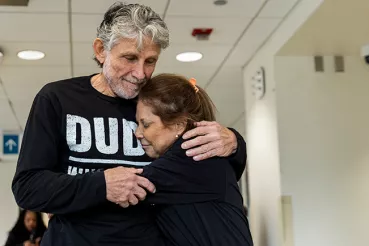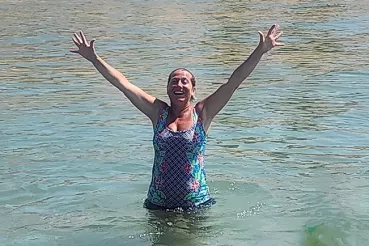When Alicia Salibellas began noticing she was having trouble swallowing, she couldn’t have predicted how the diagnosis she received would change her life and nearly rob her of her voice.
She visited her primary care physician at a Chicago-based clinic, who discovered a mass in her throat. The doctor referred her to an otorhinolaryngologist, commonly known as an ear, nose and throat doctor. A biopsy revealed Alicia’s worst fear: The mass was cancerous.
“I didn’t even give them a chance to tell me it was untreatable,” Alicia says. “I wanted a second opinion. I started looking up the top surgeons in the country and found Kerstin Stenson, MD, at Rush, which was great because I had been a patient there before and had been happy with my care.”
While the doctors who initially diagnosed Alicia feared that removing the growth in her throat would affect her ability to speak or swallow, she was determined to find a course of treatment that would not only save her life, but also her voice and independence.
“It was terrifying,” Alicia says. “I’m only 48 and I have family. I have people I love and who love me, and it was difficult to even wrap my head around. I thought ‘I’m not going to be able to learn sign language, and my family is going to have to learn how to read lips!’ But I didn’t let myself embrace that fear too much.”
Developing a treatment plan
One surgical option was to remove Alicia’s esophagus and larynx along with the tumor, though that would mean Alicia would no longer be able to speak or swallow.
“Alicia was a young, vibrant woman who showed up in my office with a really bad tumor,” says Christopher Seder, MD, a thoracic surgeon with the Rush Lung Center’s Upper Airway Program. “It was growing out of her esophagus, into the back side of her trachea and was a life-threatening growth if it wasn’t addressed soon. It was extremely important for Alicia to maintain her ability to speak, so we always kept that goal at the forefront of our treatment plans.”
Seder knew his work was cut out for him, so he and Stenson assembled a team of specialists in ENT, as well as thoracic surgery, knowing that it would require the expertise of both fields to pull the operation off.
But the surgery was not an easy one. After a portion of her esophagus was removed, the surgical team used her stomach to construct a long tube that connected to the remaining part of her throat. Once this healed, she would be able to swallow and eat normally.
Then, the entire back side of Alicia’s trachea needed to be removed. The team used an extracorporeal membrane oxygenation — or ECMO — machine, which oxygenates a person’s blood and pumps it through their body, bypassing the heart and lungs.
“The ECMO machine allowed us to ventilate Alicia while we were working on her trachea,” Seder says. “We removed the whole back side of her trachea and reconstructed it with a piece of skin from her shoulder.
“She had a great response and can still speak, thanks to the collaboration between the ENT and thoracic teams and our ability to perform and accomplish complex operations.”
Claiming her independence
While Alicia’s surgery was a success and her ability to speak and swallow would return, there was still a long road to regain her independence.
“My recovery was difficult,” Alicia says. “It wasn’t hard or painful, but it was a lot to do. When I got home, I used a feeding tube for both food and medicine. Not being able to eat or drink anything properly for weeks was crazy and strange, but I did it.”
After healing from the surgery, Alicia began daily radiation treatments. Eventually, her scans showed that the tumor had been completely removed.
For Alicia, the moment she felt like herself again was when she had her first solid meal after weeks of feeding tubes and liquid diets.
“I had a turkey burger with fries,” she says. “It was magnificent.”
While Alicia is still on the path toward feeling 100%, she is grateful for her entire care team at Rush.
“They are the best ever in this country and top notch,” she says. “Their bedside manner from beginning to end — explaining to me what was going on, all of the difficult conversations we had to have, reassuring me that I’d get through it — was amazing. In addition to the medical side, I could really tell that they cared about what I was going through and how I was going to be treated.
“It was going to work, and they were going to give me the very best outcome.”




